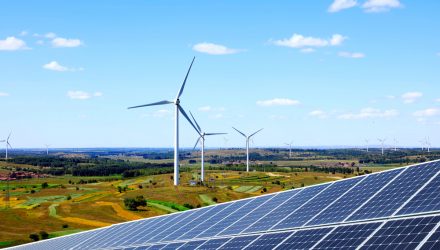Renewable energy sector-related exchange traded funds could benefit from President Joe Biden’s proposed infrastructure spending plan.
Biden has outlined a $2.3 trillion infrastructure plan that would expand subsidies to the renewable energy sector and address key bottlenecks impeding the shift to a green energy grid, the Wall Street Journal reports.
Specifically, the plan would create new tax credits to support the construction of high-voltage transmission lines, a major hurdle in the expansion of renewable energy. Additionally, it includes a proposed 10-year extension of wind, solar, and battery tax credits, which are currently set to expire in coming years.
Tax credits have “been very effective at reducing costs for wind and solar, and they could do the same for transmission,” Trey Ward, chief executive of Direct Connect Development Co., told the WSJ. “It is very simple: If you want more renewables, you need more transmission.”
Renewable energy companies were encouraged by the proposed extension of the tax credits and the push toward green energy.
“It will really unlock more markets in the United States where we’re just scratching the surface,” Suzanne Leta, head of policy and strategy for SunPower Corp., told the WSJ.
Biden argued that the spending plan is “a once-in-a-generation investment in America.”
“We need to do this or we’re never going to be able to hit decarbonization plans,” Nat Kreamer, chief executive of Advanced Energy Economy, told the WSJ.
State Street’s Green Suite
As a way to help investors tap into socially responsible investment opportunities, State Street Global Advisors offers a suite of socially responsible and ESG-related ETFs. For example, the SPDR Kensho Clean Power ETF (CNRG) seeks to provide exposure to the clean power industry in terms of both generation and underlying technology. Alternative energy sources are an increasingly important part of the power generation conversation.
The SPDR S&P 500 ESG ETF (EFIV) enhances both SPDR’s ESG and S&P 500 ETF offerings, helping investors incorporate ESG while achieving a risk and return profile comparable to the S&P 500. The ETF tracks the S&P 500 ESG Index, which is designed to measure the performance of securities meeting certain sustainability criteria (i.e. criteria related to environmental, social, and governance factors) while maintaining a similar overall industry group weight as the S&P 500 Index.
The firm’s SPDR S&P 500 Fossil Fuel Free ETF (SPYX) tries to allow climate change-conscious investors to align the core of their investment strategy with their values by eliminating companies that own fossil fuel reserves from the S&P 500.
Finally, the SPDR MSCI ACWI Low Carbon Target ETF (NYSEArca: LOWC) targets the MSCI ACWI Low Carbon Target Index, which tries to address carbon exposure by overweighting companies with low carbon emissions relative to sales and per dollar of market capitalization, as compared to the broader market. LOWC was created for the U.N. Joint Staff Pension Fund.
For more news, information, and strategy, visit the ESG Channel.

